Exergy Assessment of the Allothermal Gasification of Maize Cobs in a Concentric Tube Fixed-Bed Reactor
Abstract
1. Introduction
2. Materials and Methods
2.1. Raw Material Preparation
2.2. Characteristics of Maize Cob
2.3. Concentric Tube Gasification Reactor
2.4. Experimental Evaluation
2.5. Exergy Assessment
- The system operates under stationary conditions.
- The reference state is 298 K and 100 kPa.
- Syngas is considered to be tar-free.
- Ashes from combustion have zero exergy.
- Biochar from gasification is assumed to have the same chemical exergy as carbon (404,589 kJ/kmol).
- Syngas and combustion gasses are considered ideal gasses.
3. Results
3.1. Experimental Results
3.2. Exergy Assessment Results
4. Discussion
5. Conclusions
Supplementary Materials
Author Contributions
Funding
Institutional Review Board Statement
Informed Consent Statement
Data Availability Statement
Acknowledgments
Conflicts of Interest
References
- Mehrpooya, M.; Khalili, M.; Sharifzadeh, M.M.M. Model Development and Energy and Exergy Analysis of the Biomass Gasification Process (Based on the Various Biomass Sources). Renew. Sustain. Energy Rev. 2018, 91, 869–887. [Google Scholar] [CrossRef]
- Karamarkovic, R.; Karamarkovic, V. Energy and Exergy Analysis of Biomass Gasification at Different Temperatures. Energy 2010, 35, 537–549. [Google Scholar] [CrossRef]
- Zhao, Z.; Andre Situmorang, Y.; An, P.; Yang, J.; Hao, X.; Rizkiana, J.; Abudula, A.; Guan, G. A Biomass-Based Small-Scale Power Generation System with Energy/Exergy Recuperation. Energy Convers. Manag. 2021, 227, 113623. [Google Scholar] [CrossRef]
- Pacioni, T.R.; Soares, D.; Di Domenico, M.; Rosa, M.F.; de Fátima Peralta Muniz Moreira, R.; José, H.J. Bio-Syngas Production from Agro-Industrial Biomass Residues by Steam Gasification. Waste Manag. 2016, 58, 221–229. [Google Scholar] [CrossRef]
- Sattar, A.; Leeke, G.A.; Hornung, A.; Wood, J. Steam Gasification of Rapeseed, Wood, Sewage Sludge and Miscanthus Biochars for the Production of a Hydrogen-Rich Syngas. Biomass Bioenergy 2014, 69, 276–286. [Google Scholar] [CrossRef]
- Sohni, S.; Norulaini, N.A.N.; Hashim, R.; Khan, S.B.; Fadhullah, W.; Mohd Omar, A.K. Physicochemical Characterization of Malaysian Crop and Agro-Industrial Biomass Residues as Renewable Energy Resources. Ind. Crops Prod. 2018, 111, 642–650. [Google Scholar] [CrossRef]
- Gómez-Vásquez, R.D.; Castiblanco, E.A.; Zapata Benabithe, Z.; Bula Silvera, A.J.; Camargo-Trillos, D.A. CaCO3 and Air/Steam Effect on the Gasification and Biohydrogen Performance of Corn Cob as Received: Application in the Colombian Caribbean Region. Biomass Bioenergy 2021, 153, 106207. [Google Scholar] [CrossRef]
- Arenas Castiblanco, E.; Montoya, J.H.; Rincón, G.V.; Zapata-Benabithe, Z.; Gómez-Vásquez, R.; Camargo-Trillos, D.A. A New Approach to Obtain Kinetic Parameters of Corn Cob Pyrolysis Catalyzed with CaO and CaCO3. Heliyon 2022, 8, e10195. [Google Scholar] [CrossRef] [PubMed]
- Mendoza, J.; Rhenals-Julio, J.; Avila, A.; Durando, E. Análise Exergoeconômica Da Gasificação de Sabugo de Milho Integrado Em Um Sistema de Geração de Energia: Estudo de Caso Na Colômbia. Rev. Virtual De Quim. 2021, 13, 919–925. [Google Scholar] [CrossRef]
- Widjaya, E.R.; Chen, G.; Bowtell, L.; Hills, C. Gasification of Non-Woody Biomass: A Literature Review. Renew. Sustain. Energy Rev. 2018, 89, 184–193. [Google Scholar] [CrossRef]
- Tezer, Ö.; Karabağ, N.; Öngen, A.; Çolpan, C.Ö.; Ayol, A. Biomass Gasification for Sustainable Energy Production: A Review Int. J. Hydrog. Energy 2022, 47, 15419–15433. [Google Scholar] [CrossRef]
- Ayol, A.; Tezer Yurdakos, O.; Gurgen, A. Investigation of Municipal Sludge Gasification Potential: Gasification Characteristics of Dried Sludge in a Pilot-Scale Downdraft Fixed Bed Gasifier. Int. J. Hydrogen Energy 2019, 44, 17397–17410. [Google Scholar] [CrossRef]
- Qian, X.; Lee, S.; Chandrasekaran, R.; Yang, Y.; Caballes, M.; Alamu, O.; Chen, G. Electricity Evaluation and Emission Characteristics of Poultry Litter Co-Combustion Process. Appl. Sci. 2019, 9, 4116. [Google Scholar] [CrossRef]
- Varol, M.; Atimtay, A.T.; Olgun, H.; Atakül, H. Emission Characteristics of Co-Combustion of a Low Calorie and High Sulfur–Lignite Coal and Woodchips in a Circulating Fluidized Bed Combustor: Part 1. Effect of Excess Air Ratio. Fuel 2014, 117, 792–800. [Google Scholar] [CrossRef]
- Piekarczyk, W.; Czarnowska, L.; Ptasiński, K.; Stanek, W. Thermodynamic Evaluation of Biomass-to-Biofuels Production Systems. Energy 2013, 62, 95–104. [Google Scholar] [CrossRef]
- Kim, J.-W.; Jeong, Y.-S.; Kim, J.-S. Bubbling Fluidized Bed Biomass Gasification Using a Two-Stage Process at 600 °C: A Way to Avoid Bed Agglomeration. Energy 2022, 250, 123882. [Google Scholar] [CrossRef]
- Li, H.; Sun, C.; Zhang, Y.; Li, T.; Wei, X. Performance Investigation of the Gasification for the Kitchen Waste Powder in a Direct Current Plasma Reactor. J. Energy Inst. 2022, 100, 170–176. [Google Scholar] [CrossRef]
- Sreejith, C.C.; Haridasan, N.; Muraleedharan, C.; Arun, P. Allothermal Air–Steam Gasification of Biomass with CO2 (Carbon Dioxide) Sorption: Performance Prediction Based on a Chemical Kinetic Model. Energy 2014, 69, 399–408. [Google Scholar] [CrossRef]
- Barco-Burgos, J.; Carles-Bruno, J.; Eicker, U.; Saldana-Robles, A.L.; Alcántar-Camarena, V. Hydrogen-Rich Syngas Production from Palm Kernel Shells (PKS) Biomass on a Downdraft Allothermal Gasifier Using Steam as a Gasifying Agent. Energy Convers. Manag. 2021, 245, 114592. [Google Scholar] [CrossRef]
- Umeki, K.; Yamamoto, K.; Namioka, T.; Yoshikawa, K. High Temperature Steam-Only Gasification of Woody Biomass. Appl. Energy 2010, 87, 791–798. [Google Scholar] [CrossRef]
- Byun, Y.; Cho, M.; Hwang, S.-M.; Chung, J.; Byun, Y.; Cho, M.; Hwang, S.-M.; Chung, J. Thermal Plasma Gasification of Municipal Solid Waste (MSW). Gasif. Pract. Appl. 2012, 1, 183–210. [Google Scholar] [CrossRef]
- Rufford, T.E.; Smart, S.; Watson, G.C.Y.; Graham, B.F.; Boxall, J.; Diniz da Costa, J.C.; May, E.F. The Removal of CO2 and N2 from Natural Gas: A Review of Conventional and Emerging Process Technologies. J. Pet. Sci. Eng. 2012, 94–95, 123–154. [Google Scholar] [CrossRef]
- Mayerhofer, M.; Mitsakis, P.; Meng, X.; De Jong, W.; Spliethoff, H.; Gaderer, M. Influence of Pressure, Temperature and Steam on Tar and Gas in Allothermal Fluidized Bed Gasification. Fuel 2012, 99, 204–209. [Google Scholar] [CrossRef]
- Arena, U. Process and Technological Aspects of Municipal Solid Waste Gasification. A Review. Waste Manag. 2012, 32, 625–639. [Google Scholar] [CrossRef] [PubMed]
- Göransson, K.; Söderlind, U.; Zhang, W. Experimental Test on a Novel Dual Fluidised Bed Biomass Gasifier for Synthetic Fuel Production. Fuel 2011, 90, 1340–1349. [Google Scholar] [CrossRef]
- Cheng, G.; Li, Q.; Qi, F.; Xiao, B.; Liu, S.; Hu, Z.; He, P. Allothermal Gasification of Biomass Using Micron Size Biomass as External Heat Source. Bioresour. Technol. 2012, 107, 471–475. [Google Scholar] [CrossRef]
- Di Carlo, A.; Savuto, E.; Foscolo, P.U.; Papa, A.A.; Tacconi, A.; Del Zotto, L.; Aydin, B.; Bocci, E. Preliminary Results of Biomass Gasification Obtained at Pilot Scale with an Innovative 100 KWth Dual Bubbling Fluidized Bed Gasifier. Energies 2022, 15, 4369. [Google Scholar] [CrossRef]
- Chen, W.H.; Chen, C.J.; Hung, C.I.; Shen, C.H.; Hsu, H.W. A Comparison of Gasification Phenomena among Raw Biomass, Torrefied Biomass and Coal in an Entrained-Flow Reactor. Appl. Energy 2013, 112, 421–430. [Google Scholar] [CrossRef]
- Maitlo, G.; Unar, I.N.; Mahar, R.B.; Brohi, K.M. Numerical Simulation of Lignocellulosic Biomass Gasification in Concentric Tube Entrained Flow Gasifier through Computational Fluid Dynamics. Energy Explor. Exploit. 2019, 37, 1073–1097. [Google Scholar] [CrossRef]
- Sazali, S.N.; Al-attab, K.A.; Zainal, Z.A. Gasification Enhancement and Tar Reduction Using Air Fogging System in a Double Walled Downdraft Biomass Gasifier. Energy 2019, 186, 115901. [Google Scholar] [CrossRef]
- Xiao, Y.; Xu, S.; Song, Y.; Shan, Y.; Wang, C.; Wang, G. Biomass Steam Gasification for Hydrogen-Rich Gas Production in a Decoupled Dual Loop Gasification System. Fuel Process. Technol. 2017, 165, 54–61. [Google Scholar] [CrossRef]
- Jahromi, R.; Rezaei, M.; Hashem Samadi, S.; Jahromi, H. Biomass Gasification in a Downdraft Fixed-Bed Gasifier: Optimization of Operating Conditions. Chem. Eng. Sci. 2021, 231, 116249. [Google Scholar] [CrossRef]
- Prins, M.J.; Ptasinski, K.J.; Janssen, F.J.J.G. From Coal to Biomass Gasification: Comparison of Thermodynamic Efficiency. Energy 2007, 32, 1248–1259. [Google Scholar] [CrossRef]
- Shahbeig, H.; Shafizadeh, A.; Rosen, M.A.; Sels, B.F. Exergy Sustainability Analysis of Biomass Gasification: A Critical Review. Biofuel Res. J. 2022, 9, 1592–1607. [Google Scholar] [CrossRef]
- Caglar, B.; Tavsanci, D.; Biyik, E. Multiparameter-Based Product, Energy and Exergy Optimizations for Biomass Gasification. Fuel 2021, 303, 121208. [Google Scholar] [CrossRef]
- Rashidi, H.; Khorshidi, J. Exergy Analysis and Multiobjective Optimization of a Biomass Gasification Based Multigeneration System. Int. J. Hydrogen Energy 2018, 43, 2631–2644. [Google Scholar] [CrossRef]
- Samimi, F.; Marzoughi, T.; Rahimpour, M.R. Energy and Exergy Analysis and Optimization of Biomass Gasification Process for Hydrogen Production (Based on Air, Steam and Air/Steam Gasifying Agents). Int. J. Hydrogen Energy 2020, 45, 33185–33197. [Google Scholar] [CrossRef]
- Manzini, F.; Islas-Samperio, J.M.; Grande-Acosta, G.K. Exploring Corn Cob Gasification as a Low-Carbon Technology in the Corn Flour Industry in Mexico. Energies 2024, 17, 2256. [Google Scholar] [CrossRef]
- Anukam, A.I.; Goso, B.P.; Okoh, O.O.; Mamphweli, S.N. Studies on Characterization of Corn Cob for Application in a Gasification Process for Energy Production. J. Chem. 2017, 2017, 6478389. [Google Scholar] [CrossRef]
- Saito, Y.; Sakuragi, K.; Shoji, T.; Otaka, M. Expedient Prediction of the Fuel Properties of Carbonized Woody Biomass Based on Hue Angle. Energies 2018, 11, 1191. [Google Scholar] [CrossRef]
- Antwi-Boasiako, C.; Acheampong, B.B. Strength Properties and Calorific Values of Sawdust-Briquettes as Wood-Residue Energy Generation Source from Tropical Hardwoods of Different Densities. Biomass Bioenergy 2016, 85, 144–152. [Google Scholar] [CrossRef]
- Djurdjevic, M.; Papuga, S. Torrefaction: Process Parameters and Reactor Design. Period. Polytech. Chem. Eng. 2023, 67, 416–426. [Google Scholar] [CrossRef]
- Bakisgan, C.; Dumanli, A.G.; Yürüm, Y. Trace Elements in Turkish Biomass Fuels: Ashes of Wheat Straw, Olive Bagasse and Hazelnut Shell. Fuel 2009, 88, 1842–1851. [Google Scholar] [CrossRef]
- ASTM ASTM D3173; Standard Test Method for Moisture in the Analysis Sample of Coal and Coke. ASTM International: West Conshohocken, PA, USA, 2017.
- ASTM ASTM D3175; Standard Test Method for Volatile Matter in the Analysis Sample of Coal and Coke. ASTM International: West Conshohocken, PA, USA, 2018.
- ASTM ASTM D3174; Standard Test Method for Ash in the Analysis Sample of Coal and Coke from Coal. ASTM International: West Conshohocken, PA, USA, 2018.
- ASTM ASTM D3172; Standard Test Method for Fixed Carbon in the Analysis Sample of Coal and Coke. ASTM International: West Conshohocken, PA, USA, 2017.
- Qian, X.; Xue, J.; Yang, Y.; Lee, S.W. Thermal Properties and Combustion-related Problems Prediction of Agricultural Crop Residues. Energies 2021, 14, 4619. [Google Scholar] [CrossRef]
- Motta, I.L.; Marchesan, A.N.; Maciel Filho, R.; Wolf Maciel, M.R. Correlating Biomass Properties, Gasification Performance, and Syngas Applications of Brazilian Feedstocks via Simulation and Multivariate Analysis. Ind. Crops Prod. 2022, 181, 114808. [Google Scholar] [CrossRef]
- Gomez, R.D.; Palacio, M.; Arango, J.F.; Avila, A.E.; Mendoza, J.M. Evaluation of the Energy Generation Potential by an Experimental Characterization of Residual Biomass Blends from Córdoba, Colombia in a Downdraft Gasifier. Waste Manag. 2021, 120, 522–529. [Google Scholar] [CrossRef] [PubMed]
- Hasanzadeh, R.; Mojaver, P.; Azdast, T.; Khalilarya, S.; Chitsaz, A.; Rosen, M.A. Decision Analysis for Plastic Waste Gasification Considering Energy, Exergy, and Environmental Criteria Using TOPSIS and Grey Relational Analysis. Process Saf. Environ. Prot. 2023, 174, 414–423. [Google Scholar] [CrossRef]
- Mu, R.; Liu, M.; Yan, J. Advanced Exergy Analysis on Supercritical Water Gasification of Coal Compared with Conventional O2-H2O and Chemical Looping Coal Gasification. Fuel Process. Technol. 2023, 245, 107742. [Google Scholar] [CrossRef]
- Mojaver, M.; Azdast, T.; Hasanzadeh, R. Assessments of Key Features and Taguchi Analysis on Hydrogen Rich Syngas Production via Gasification of Polyethylene, Polypropylene, Polycarbonate and Polyethylene Terephthalate Wastes. Int. J. Hydrogen Energy 2021, 46, 29846–29857. [Google Scholar] [CrossRef]
- Bejan, A. Advanced Engineering Thermodynamics; Wiley: Hoboken, NJ, USA, 2016; ISBN 9781119052098. [Google Scholar]
- Costa, V.A.F.; Tarelho, L.A.C.; Sobrinho, A. Mass, Energy and Exergy Analysis of a Biomass Boiler: A Portuguese Representative Case of the Pulp and Paper Industry. Appl. Therm. Eng. 2019, 152, 350–361. [Google Scholar] [CrossRef]
- Ayub, Y.; Zhou, J.; Ren, J.; Wang, Y.; Shen, W.; He, C.; Dong, L.; Toniolo, S. Plasma Gasification Based Monetization of Poultry Litter: System Optimization and Comprehensive 5E (Energy, Exergy, Emergy, Economic, and Environmental) Analysis. Energy Convers. Manag. 2023, 282, 116878. [Google Scholar] [CrossRef]
- Panopoulos, K.D.; Fryda, L.; Karl, J.; Poulou, S.; Kakaras, E. High Temperature Solid Oxide Fuel Cell Integrated with Novel Allothermal Biomass Gasification: Part II: Exergy Analysis. J. Power Sources 2006, 159, 586–594. [Google Scholar] [CrossRef]
- Arango, J.; Gonzalez, L. Evaluación Del Potencial Energético De La Gasificación En Lecho Fijo Para Cuatro Biomasas Residuales En El Departamento De Córdoba, Universidad Pontificia Bolivariana: Montería-Colombia, 2016.
- Biagini, E.; Barontini, F.; Tognotti, L. Gasification of Agricultural Residues in a Demonstrative Plant: Corn Cobs. Bioresour. Technol. 2015, 173, 110–116. [Google Scholar] [CrossRef] [PubMed]
- Martillo Aseffe, J.A.; Martínez González, A.; Jaén, R.L.; Silva Lora, E.E. The Corn Cob Gasification-Based Renewable Energy Recovery in the Life Cycle Environmental Performance of Seed-Corn Supply Chain: An Ecuadorian Case Study. Renew. Energy 2021, 163, 1523–1535. [Google Scholar] [CrossRef]
- Martínez González, A.; Lesme Jaén, R.; Silva Lora, E.E. Thermodynamic Assessment of the Integrated Gasification-Power Plant Operating in the Sawmill Industry: An Energy and Exergy Analysis. Renew. Energy 2020, 147, 1151–1163. [Google Scholar] [CrossRef]
- Mountouris, A.; Voutsas, E.; Tassios, D. Solid Waste Plasma Gasification: Equilibrium Model Development and Exergy Analysis. Energy Convers. Manag. 2006, 47, 1723–1737. [Google Scholar] [CrossRef]
- Moshi, R.E.; Kivevele, T.T.; Jande, Y.A.C. The Exergy Analysis for the Air Gasification in a Hybrid Fixed Bed Gasifier. Curr. Appl. Sci. Technol. 2021, 18–30. [Google Scholar] [CrossRef]
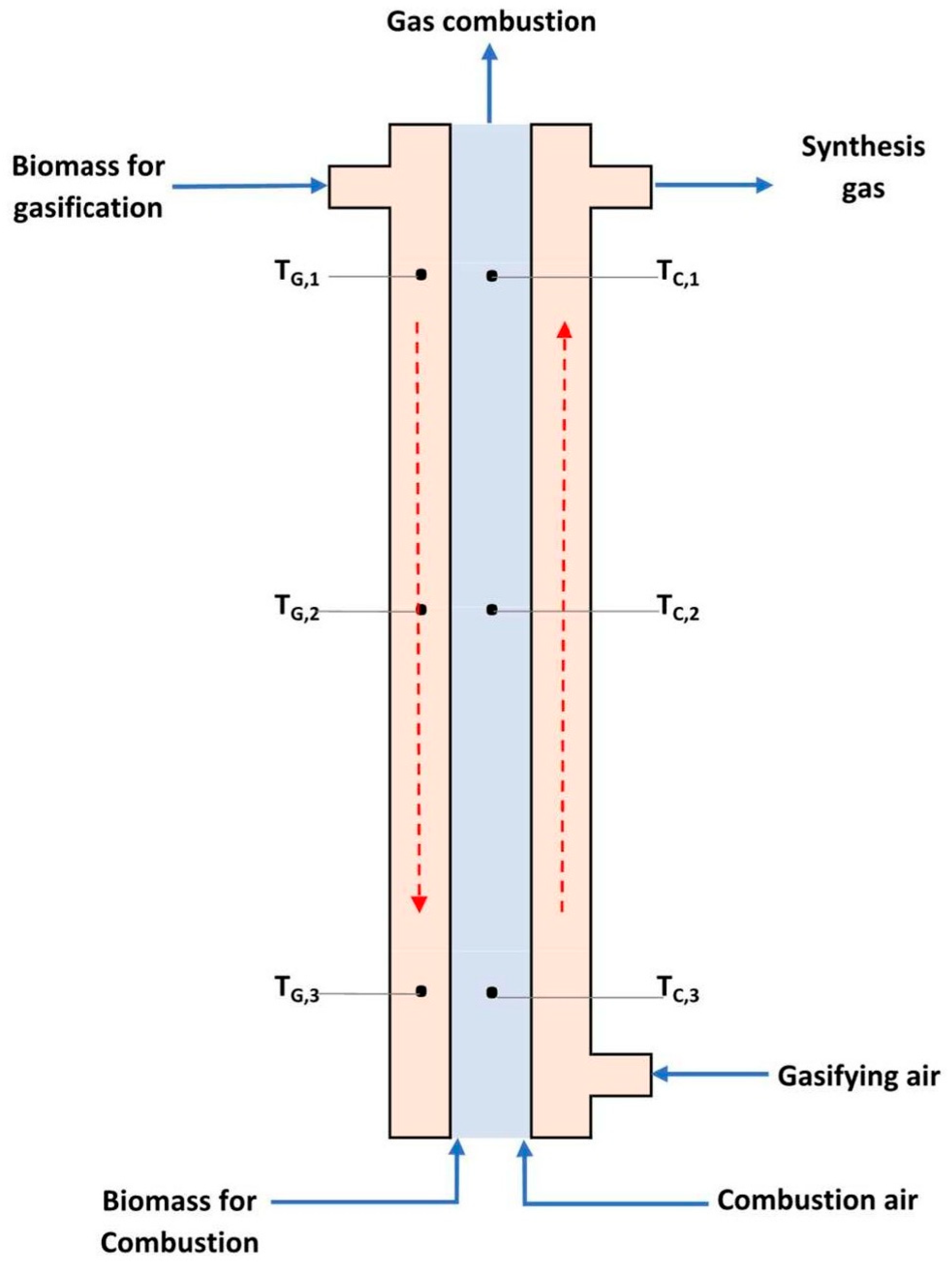
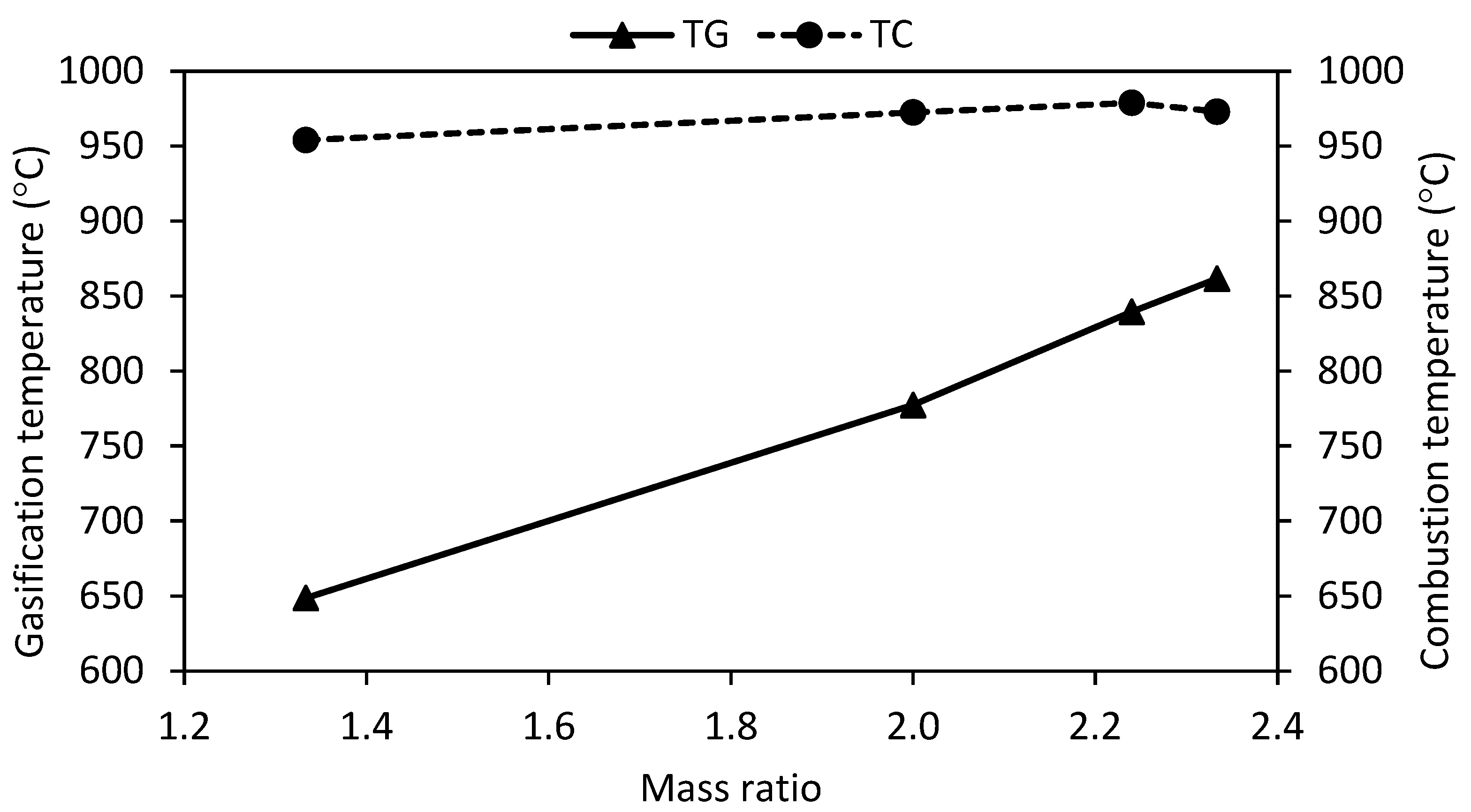

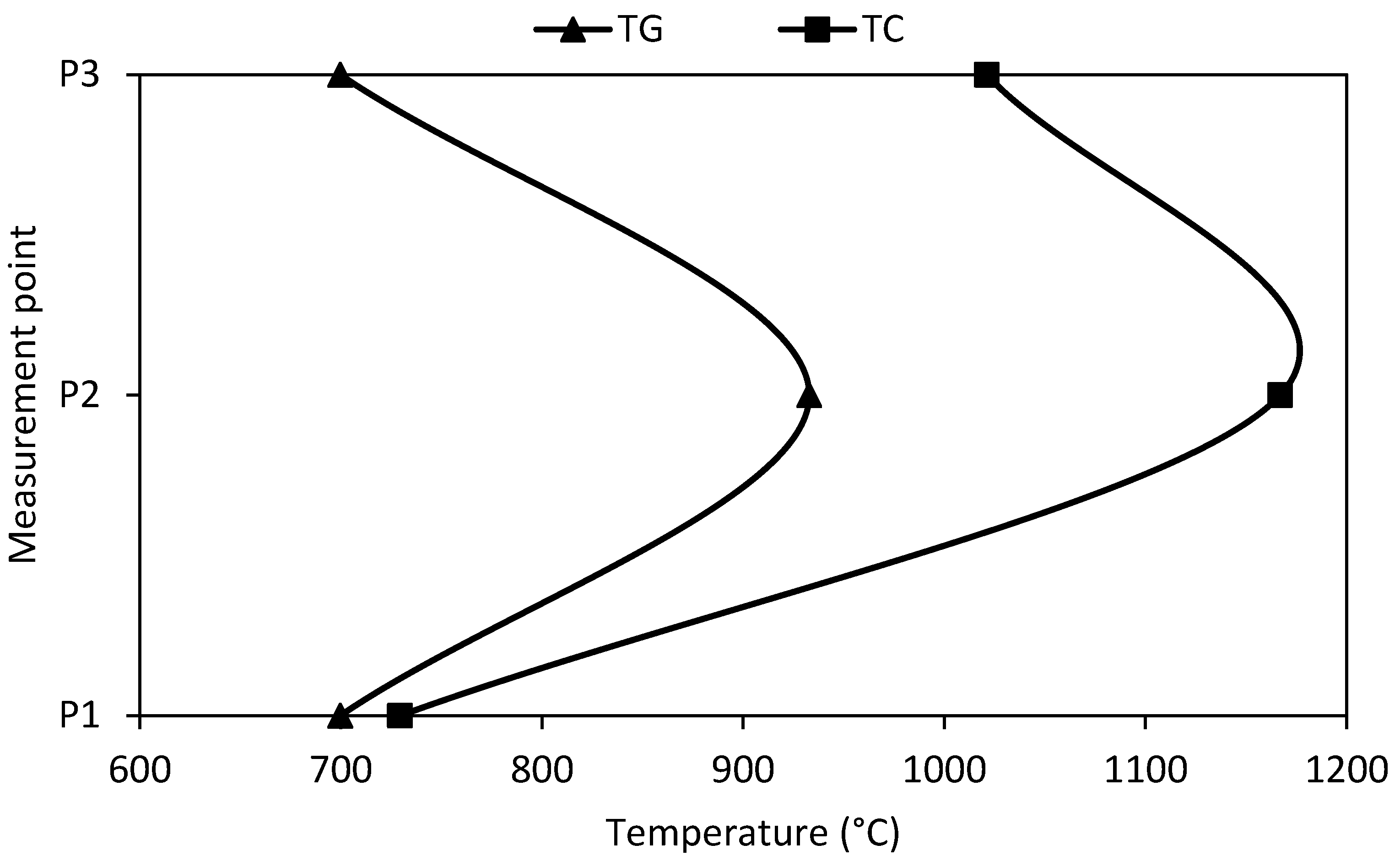
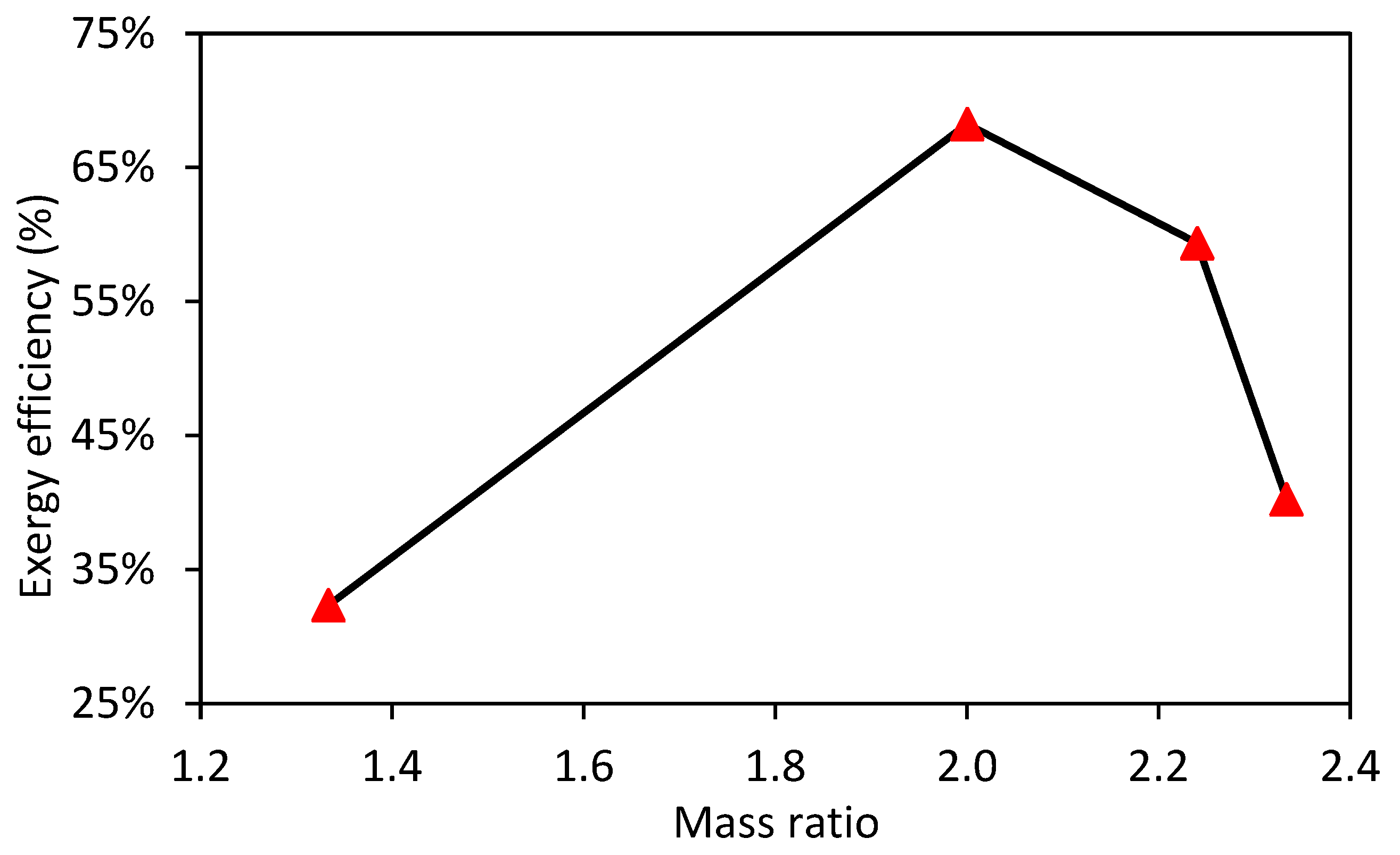
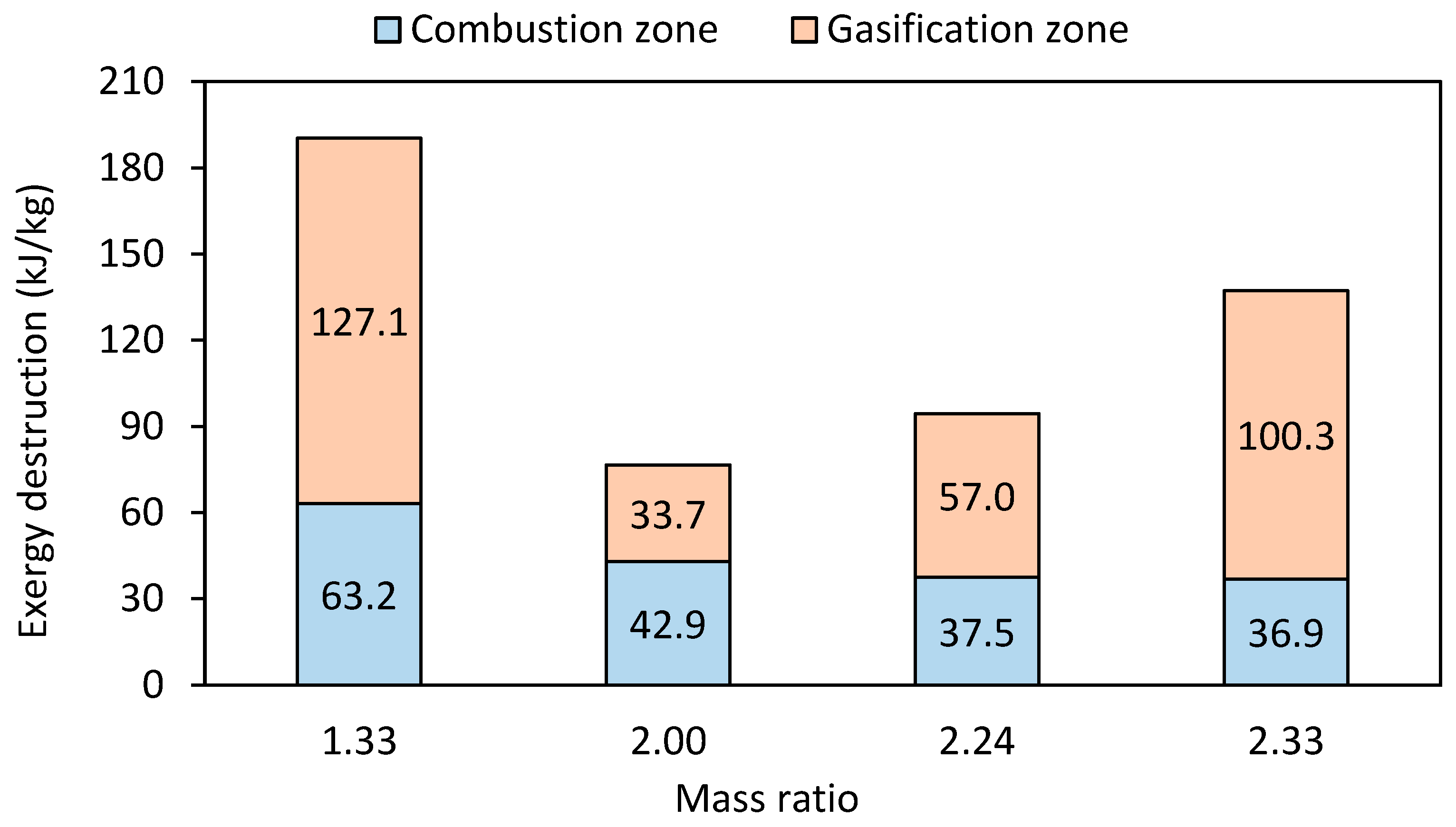
| Analysis | Parameter | Value (wt. %) |
|---|---|---|
| Elemental | C | 39.3 |
| H | 4.97 | |
| N | 0.6 | |
| S | 0.0 | |
| O | 47.42 | |
| Proximal | Moisture (%) | 10.52 |
| Fixed carbon (%) | 16.54 | |
| Volatile matter (%) | 65.23 | |
| Ash (%) | 7.71 | |
| HHV (MJ/kg) | 14.3 |
| Experiment | Biomass Supply Rate | |
|---|---|---|
| Combustion (kg) | Gasification (kg) | |
| 1 | 0.75 | 1.0 |
| 2 | 1.00 | 2.0 |
| 3 | 1.25 | 2.8 |
| 4 | 1.50 | 3.5 |
| Substance | Chemical Formula | (kJ/kmol) |
|---|---|---|
| Methane | CH4 | 831,650 |
| Hydrogen | H2 | 236,100 |
| Carbon dioxide | CO2 | 19,870 |
| Carbon monoxide | CO | 275,100 |
| Oxygen | O2 | 3970 |
| Nitrogen | N2 | 720 |
| Water (steam) | H2O | 9500 |
Disclaimer/Publisher’s Note: The statements, opinions and data contained in all publications are solely those of the individual author(s) and contributor(s) and not of MDPI and/or the editor(s). MDPI and/or the editor(s) disclaim responsibility for any injury to people or property resulting from any ideas, methods, instructions or products referred to in the content. |
© 2025 by the authors. Licensee MDPI, Basel, Switzerland. This article is an open access article distributed under the terms and conditions of the Creative Commons Attribution (CC BY) license (https://creativecommons.org/licenses/by/4.0/).
Share and Cite
Rhenals-Julio, J.D.; Mendoza, J.M.; Jaramillo, A.F.; Sagastume Gutiérrez, A.; Bula Silvera, A. Exergy Assessment of the Allothermal Gasification of Maize Cobs in a Concentric Tube Fixed-Bed Reactor. Energies 2025, 18, 606. https://doi.org/10.3390/en18030606
Rhenals-Julio JD, Mendoza JM, Jaramillo AF, Sagastume Gutiérrez A, Bula Silvera A. Exergy Assessment of the Allothermal Gasification of Maize Cobs in a Concentric Tube Fixed-Bed Reactor. Energies. 2025; 18(3):606. https://doi.org/10.3390/en18030606
Chicago/Turabian StyleRhenals-Julio, Jesús D., Jorge M. Mendoza, Andrés F. Jaramillo, Alexis Sagastume Gutiérrez, and Antonio Bula Silvera. 2025. "Exergy Assessment of the Allothermal Gasification of Maize Cobs in a Concentric Tube Fixed-Bed Reactor" Energies 18, no. 3: 606. https://doi.org/10.3390/en18030606
APA StyleRhenals-Julio, J. D., Mendoza, J. M., Jaramillo, A. F., Sagastume Gutiérrez, A., & Bula Silvera, A. (2025). Exergy Assessment of the Allothermal Gasification of Maize Cobs in a Concentric Tube Fixed-Bed Reactor. Energies, 18(3), 606. https://doi.org/10.3390/en18030606






